To me, community values are about how we care for one another and help our school feel safe, welcoming, and a place where everyone feels a sense of belonging.
It’s being kind and curious, listening well, and building trust. It’s working together.
Onboarding is about being an ambassador of EPS culture, community, making space for different voices, and showing up for each other—whether that’s at an event, in a meeting, or just day-to-day.
And when things get tricky, it means having the difficult conversations with honesty and grace.
At the heart of it, community values are about choosing connection—again and again.
Community Value from the Lens of 6th & 9th Grade Onboarding
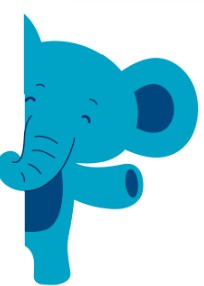
In 2024, our Admissions team gathered a Listening Group to better understand where newly enrolled students might be hitting bumps in the road—whether social, academic, or navigating daily life at EPS.
The most talked-about topic was onboarding, specifically for sixth and ninth graders. As I dug deeper into onboarding, it began to feel a bit like the elephant in the room. We all know it’s important, we all know there are better ways for it to happen, but…
Onboarding is all about community values! I’m excited to share my Community Values Indicators through the process of learning about our current onboarding process and what I’ve discovered so far: the thoughtful work already happening, and the wish-list hopes for how we continue to strengthen this important and foundation-building part of the EPS experience.
These are ideas—starting points gathered from my reflections and conversations with others in our community. They’re meant to spark thinking.
Getting Started
I began this process by thinking about who would know the most about the experience our new sixth and ninth graders are currently having: Students, Parent/Guardians, Grade Level Coordinators, Counselors, Advisors, Randi and Leah, Krista, and Learning Support.
Everyone I reached out to enthusiastically agreed to engage and developed a productive relationship by trusting me with their thoughts and ideas. Thank you to everyone who took the time to share their ideas. Your dedication to the full student experience and well-being inside and outside the classroom is inspiring!
Onboarding Goals
In a recent Admissions Team meeting, Cheryl asked us to reflect on an interaction with a group, company, or organization that was new to us. We all had different examples, however, the underlying themes were similar:
- Building connections
- Clear communication
- Kindness
- Helpfulness
- Knowledgeable
- Consistancy
- Transparency
These are similar to the goals for onboarding and align with the Community Value indicators.
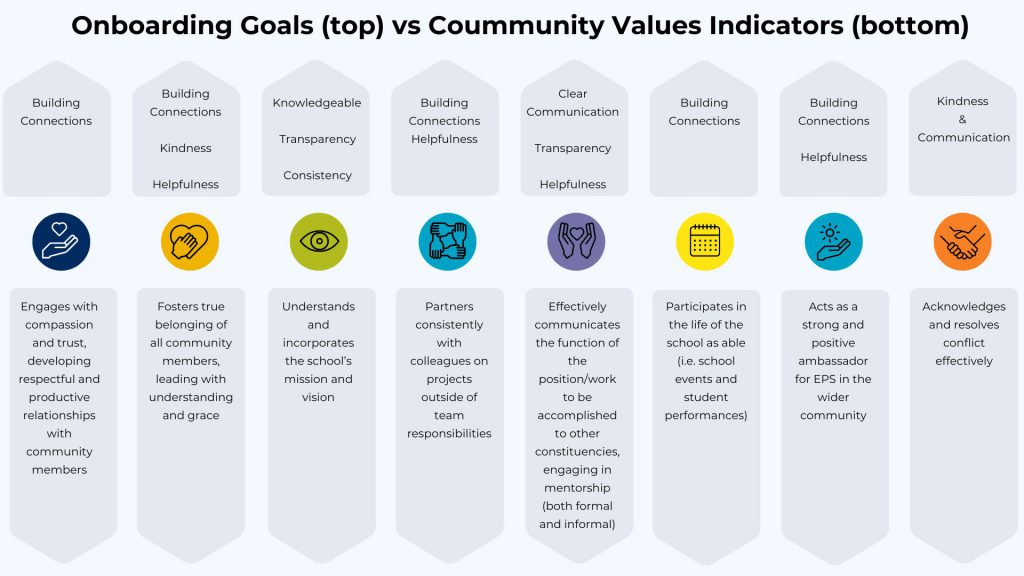
In 6th and 9th grade, families are joining groups that have already had time to build community and have experience with EPS life.
Onboarding Timeline & Experiences
EPS Engagement: Enrollment-First Day of School
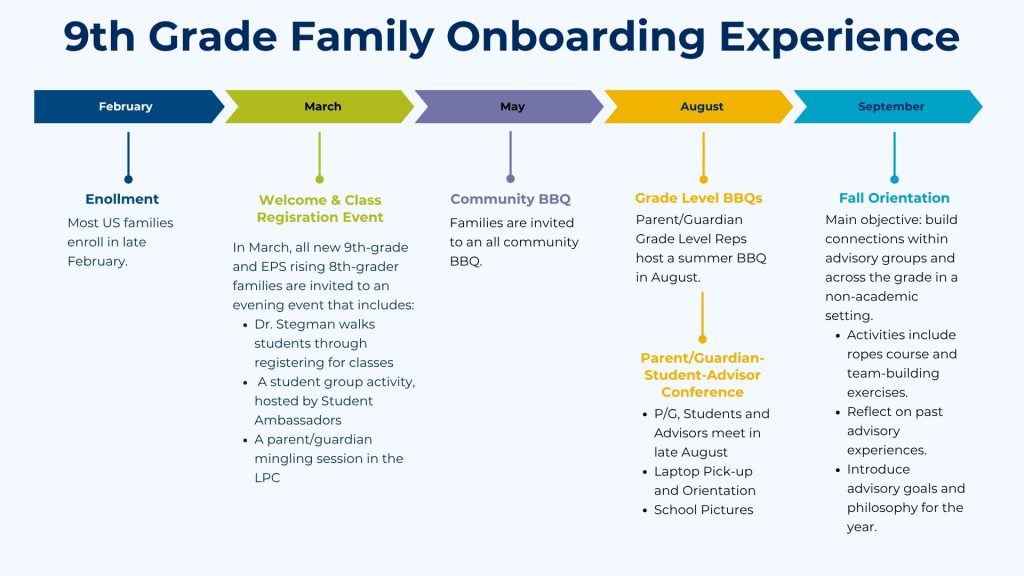
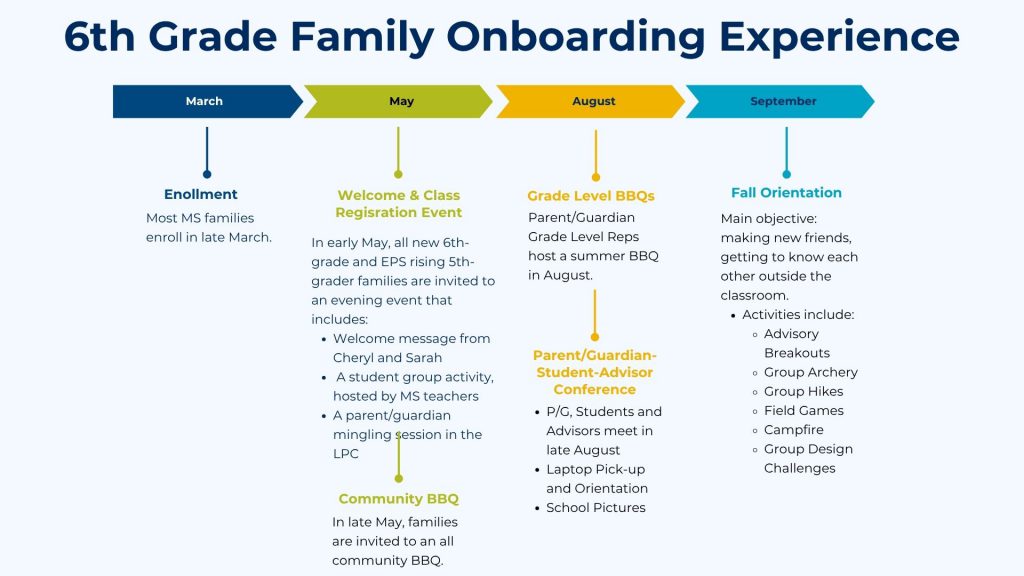
Onboarding After School Starts
A consistent, community-planned onboarding for new families starts to trickle off, if not stops, once school starts, replaced with all community events.
Breaking Down Onboarding Using the Community Values Indicators
There’s no shortage of thoughtful suggestions for improving the onboarding experience. It’s clear this is something our community cares deeply about. While this PDP may be coming to a close, the work continues. With that in mind, I’ve pulled together a few themes that came up consistently—ideas that seem to resonate across roles and experiences.

Larger Program Changes AKA Acknowledges and resolves conflict effectively. (A bit of stretch, but sometimes, when larger structural changes are suggested, there can be more hesitation.)
Some of the bigger ideas that came up would mean taking a closer look at our current programming—from Advisory to class scheduling. Here are a few themes that stood out:
More Yearlong Classes:
Right now, science is the only class all ninth graders take for the full year. Adding more yearlong classes in core subjects could create a stronger sense of stability and help students build lasting relationships with teachers and classmates. Electives would still offer room for choice and exploration.
Wellness Education, Advisory, and Study Hall:
There’s a lot of potential here to create a more cohesive and supportive experience.
- Advisory is starting to feel more like a to-do list than a time for connection. There’s a desire to bring back the relationship-building and support that should be at the heart of it.
- Wellness Education is currently taken at different times throughout the year, depending on the student. We could create a more unified Wellness program, where all students receive the same lessons at the same time—ideally timed to what they’re experiencing.
Example: Start the year with Learning Skills so students are set up for success, then move into more personal topics once they’ve had time to build trust with each other. - Study Hall could be used more intentionally. The first half could be set aside for Wellness and general check-ins or tasks. If Study Halls are scheduled at the same time, groups could even be combined for Wellness lessons.
These ideas point toward simple changes that could make a big impact on student experience—without losing the flexibility and choice students value.

Engages with compassion and trust, developing respectful and productive relationships with community members
- Considering New Students & Families Throughout the Year
- Host New Student Lunches to check in, build connection, and offer a space for questions after they’ve had a chance to settle in.
- Offer a Tech Check-In a few weeks in, once students have been using EPS platforms. This gives them a chance to ask questions or clear up any confusion.
- Onboarding Conversations
- Admissions and maybe SLT, schedule a conversation wtih newly enrolled families to answer questions, share what to expect next, and talk about ways EPS can support the family.
- Towards the end of their first year with EPS, admission schedules a call with all new families to discuss what went well, what could have been better, and answer any questions.

Fosters true belonging of all community members, leading with understanding and grace
A feeling of belonging can look and feel different to each student and family. It can be the “little” day-to-day interactions and experiences that can make a difference.
Onboarding Conversations
- Admissions and maybe SLT, schedule a conversation wtih newly enrolled families to answer questions, share what to expect next, and talk about ways EPS can support the family.
- Towards the end of their first year with EPS, admission schedules a call with all new families to discuss what went well, what could have been better, and answer any questions.

Understands and incorporates the school’s mission and vision
Let’s look at onboarding through the mission and vision.
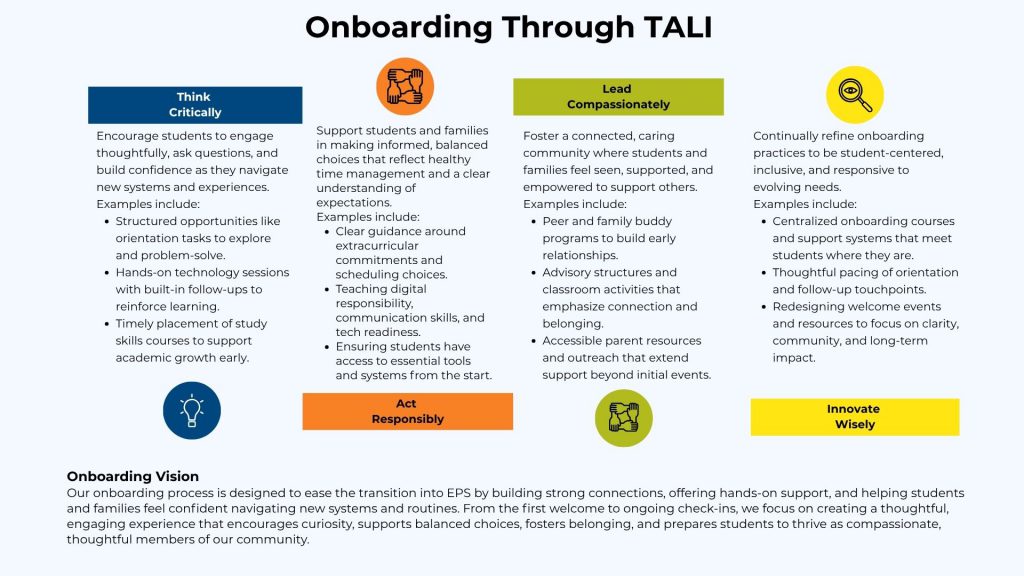

Partners consistently with colleagues on projects outside of team responsibilities
Onboarding touches many parts of our community, but right now, no one is clearly owning the full experience. As a result, much of the responsibility falls on just a few people—like GLCs and yearlong class teachers.
A Proposal: Admissions Takes the Lead
Why Admissions? Families already know and trust this team. We’ve built relationships during the admissions process, and we’re in a unique position to help bridge the transition into the school year.
What Could This Look Like?
Free up time and energy to focus on newly enrolled families!
How?
Right now, with the help of SLT, we spend over 850 hours a year on Parent/Guardian Interviews—that’s about 107 full workdays. What if we redirected some of that time to focus on building an even better experience for new families?
Great, but how do we keep the smaller, connected feel in the admissions process, that we are known for?
We consistently hear from families that one of their favorite moments in the admissions process is seeing the EPS community in action—especially during Saturday Preview Events. Instead of traditional interviews, we could offer Community Connection Panels, featuring voices from across EPS: SLT, faculty, students, and current parents/guardians.
These panels could be built around themes, similar to the virtual sessions we ran during COVID, but with more specific themes. This could be a more welcoming, community-centered way to introduce families to life at EPS.
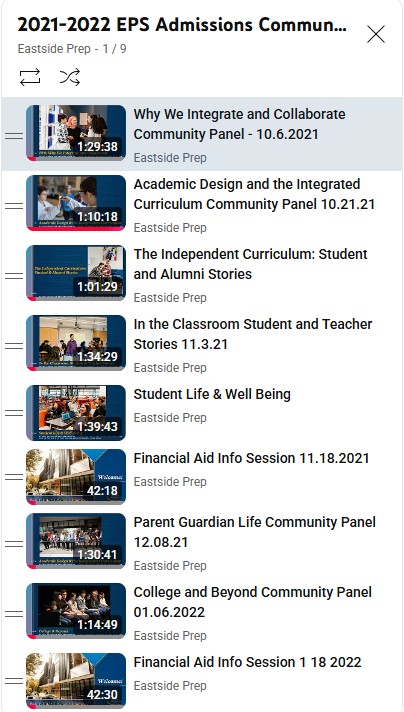

Effectively communicates the function of the position/work to be accomplished to other constituencies, engaging in mentorship
We do provide a lot of great resources and communication—but let’s take a step back and try to see it all through the eyes of a new family. Chances are, they’re juggling a lot and might be feeling overwhelmed by the flow of emails, tools, and unfamiliar terms. How can we help them feel more confident, informed, and able to navigate EPS on their own?
Idea: Create a “New Family” Page on the Current Families Website
A centralized, easy-to-navigate space could go a long way. It might include:
- A “Who to Go To” Guide for both students and families
- A short video series on EPS culture (because some things are just easier to hear in a friendly voice!)
- An EPS Terms Glossary — because let’s face it, we definitely speak our own language here
- How to use Canvas as a parent (emphasizing that the goal isn’t grade-watching, but staying informed)
- An overview of parent/guardian life and ways to get involved
- How to make the most of the Current Families website
- Using TeamSnap effectively
- Managing the Overly Scheduled Student — explaining how extracurricular choices work and how to find balance at EPS
Buddy Systems: A Simple but Powerful Theme
Being new can sometimes mean not knowing who to ask—or not feeling comfortable doing so. Buddy systems came up again and again as a meaningful way to help:
- Student Peer Buddies who can help with day-to-day logistics, answer small questions, and offer a friendly face during transition
- Family Buddy Program that connects new families with current ones who can help explain events, timelines, and traditions—and ideally, match families who speak the same home language when possible
A little clarity and connection can go a long way in helping families feel like they truly belong.

Participates in the life of the school as able (i.e. school events and student performances)
Look at Community Events Through a New Family Lens:
- Make sure there are current families available to partner with new families at events.
- Explain the purpose of events, what to expect, dress code, etc. A little context can make a big difference.
- Break down all the mysterious EPS acronyms (you all know we speak our own language here).

Acts as a strong and positive ambassador for EPS in the wider community
There’s nothing like learning about EPS from those who live it every day. Creating more chances for new families to connect with current students and parents not only builds familiarity but also deepens their understanding of what makes EPS special.
Eagle Day: A Welcome Before the Rush
This event would happen before the usual back-to-school activities—late August, around when new faculty start—to give new families a relaxed, early introduction to campus life.
- For Students:
- A guided tour and scavenger hunt/passport led by Peer Mentors or Student Leaders
- They’ll explore key spots like their classrooms, the gym, makerspaces, candy stations, sports courts, art and tech rooms, learning support, theatre, and more
- Along the way, students will hear firsthand stories about life at EPS
- Choose Your Own Activity:
After the tour, students can pick between a more active time in the gym or a creative session in the makerspaces—a low-key chance to connect and have fun together
- A guided tour and scavenger hunt/passport led by Peer Mentors or Student Leaders
- For Parents/Guardians:
- A meet-and-greet in the LPC to welcome new families
- Campus tours led by Parent/Guardian Ambassadors who can share insights and answer questions
Reflection
This work has reminded me how deeply our community, and I personally, care about creating a sense of belonging—and how even small adjustments can make a big difference for students and families stepping into something new.
I am excited and hopeful to continue playing a role in the evolution of our onboarding experiences. The ideas are out there, the care is real, and the work is ongoing. Onboarding is more than a checklist—it’s a reflection of who we are. And we have a chance to create that vision, together!